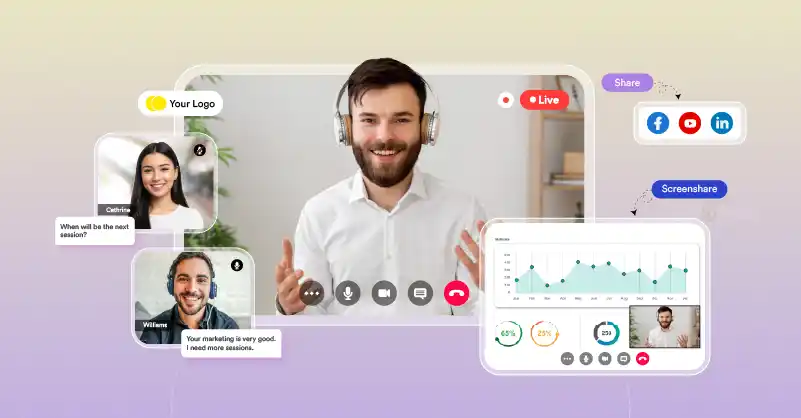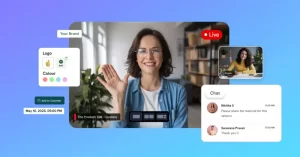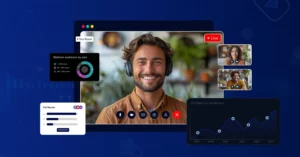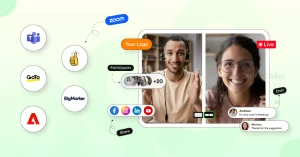Webinars have rapidly reshaped digital marketing strategies by expanding their reach, fostering engagement and driving results no matter the geographical boundaries. Nowadays, 64% of all B2B marketers have been hosting webinars to educate and convert their target audience. In order to cope up with this demand, the webinar hosting market is expected to grow at a 16.8% CAGR, reaching over $266.46 billion by 2029.
By turning passive viewers into active participants on a global scale, webinars have proven to be a powerful tool for businesses of all sizes. In 2025, if you’re looking to create and host a webinar for training, sales or thought leadership, then the right tools and techniques are needed to succeed and stand out. In this guide, we will explain to you how to plan, structure and host the most engaging and successful webinar that’ll captivate your audience and move your business forward.
✨Who is a webinar host?
A webinar host is the person responsible for setting up a webinar, introducing the speakers and engaging with the viewers starting from registration until the online event ends. In a live session, hosts moderate Q&A, polls, and more to keep their viewers involved. Basically, the webinar host is the driving force that turns a static webcast into something dynamic and interactive.
✨What are the roles of a webinar host?
- Planning, scheduling, and guiding the entire webinar session.
- Configuring technical settings on the chosen webinar platform.
- Sending invites and follow-up emails to viewers.
- Welcoming attendees, introducing speakers and presenters.
- Controlling microphones, cameras, spotlighting videos and even screen sharing
- Maximising reach on pre & post webinar sessions.
- Examines the engagement metrics and gathers feedback post event.
- Repurposes webinar recordings for on-demand viewing and social media sharing.
89% of hosts said that webinars are the best way to showcase expertise, experience & business growth.
✨Why Should a Host Conduct Webinars?
Webinar planning isn’t a digital trend; it is a proven way to have real conversations with your audience and expand your reach in a hyper-connected world. Whatever your goal may be, these are the main benefits you need to know before conducting webinars:
Increase user engagement: Live webinars let you talk to viewers in real-time. Polls, Q&As and chat turn passive listeners into active participants and turn your ordinary sessions memorable.
Training & Education: Webinars help you break down difficult topics to make it easier for your audience. Sharing slides, live demos or inviting guest speakers makes learning engaging for everyone.
Lead generation: Webinar attendees provide you with a list of potential leads for outreach, nurturing, and sales, all from one interactive session.
✨How to Create a Successful Webinar?
Hosting a successful webinar depends on clear and thoughtful planning. To make your webinar stand out from the rest of the crowd you need to follow these steps before, during and after the session. We know that every webinar is unique, but focusing on these steps will definitely lead you to hosting a webinar that is both successful and impacting.
➨Step 1: Choose a Topic
Identify and pick a subject that will be valuable and engaging for your target audience. The topic can be anything that aligns with your business goals, audience interests, showcasing new products, or even industry trends.
If you are still not sure, you can get inspiration by using tools like “Answer the Public” or “Also Asked” and look for what your audience is searching for online.
➨Step 2: Pick the Right Webinar Platform
Selecting a reliable live webinar platform that fits your needs is crucial. As each of these webinar hosting platforms has its own pros and cons, like:
- GUDSHO – One of the best alternatives to streamyard, that merges Live sessions with a powerful set of video marketing tools such as seamless hosting, editing, analytics, and social media integration into one unified dashboard.
- Demio – A well-known webinar management platform that offers HD live and automated events, real-time polls, Q&A, and robust engagement analytics so marketers/businesses can connect, convert, and measure success without downloading anything.
- GoTo Webinar – An enterprise-level webinar hosting platform that provides hassle-free virtual events with HD audio, Q&A, and customizable registration pages. Reach your audiences worldwide by hosting up to 3000 attendees, 360 analytics and CRM integrations.
➨Step 3: Must-Have Features on a Webinar Platform
The right webinar platform is like choosing a co-pilot for your webinar journey. Below are essential features to make webinar creation easy, secure & engaging:
- Video/audio conferencing helps connect multiple people from different places and devices, with clear video and crisp sound.
- Session recordings of webinars are useful for repurposing your content as on-demand sessions and social media posts.
- Screen sharing lets you share presentations, tutorials or live software demos with your attendees.
- Session materials upload provides handouts, slides or cheat sheets for instant participant downloads.
- Quick Surveys or interactive polls are simple and quick, which tend to keep your audience interested & awake.
- Session analytics let you track how many people joined, how long they stayed and what caught their attention.
➨Step 4: Decide on a Webinar Format
There are various webinar event formats for you to choose from and it depends on your goals as each have their own advantage.
- Single and Multi Presenter: A traditional type of webinar where single or multiple speakers host a session through a slideshow or presentation.
- Panel Discussion: Here multiple experts are hosted on a session and engage in a moderated discussion on a specific topic or title to provide various perspectives.
- Q&A Session: This is more like an ask-anything type of session, where the presenter answers to the audience questions that can either be related to the presentation or general.
- Product Demo/Workshop: A format that is purely focused on showcasing how a product, software or tool functions and how it can be useful to the viewer.
- Interview or Press Conference: This is where a host conducts a virtual interview with one or more guests who are often experts in their field or industry leaders.
- Educational Webinars: This allows educators to provide an interactive learning experience to students remotely. It can be of a specific subject, chapter or topic.
- Training and Certification: These webinars are designed to focus on learning or improving new skills for career development.
➨Step 5: Assign Roles
You can select your webinar team and assign specific roles and responsibilities to each member. With this type of webinar management system, you can prevent chaos during your live sessions.
- A host or organizer to take charge of planning and leading the webinar strategy.
- A moderator to manage the BTS process like engagement tools, audio & video quality, and filter audience questions.
- A speaker or presenter to deliver the content/message.
➨Step 6: Set a Date and Time
Before planning a webinar’s date and time, you need to analyze your target audience’s time zones and habits based on its geography and your niche type. But in order to maximize the attendance to your event, hosting it on Tuesdays, Wednesdays and Thursdays often works the best.
➨Step 7: Build a Registration Page
Before starting the online event and promotional activities you need to create a landing page that matches your brand’s tone and color. Using this page you can collect your attendees data, see the number of members who might attend and later send them reminders/notification of your event.
- A catchy webinar title that attracts potential attendees
- Purpose of the webinar
- Webinar’s benefits in bullet points
- The speaker/presenter bios
- A quick & simple signup form
➨Step 8: Come up with a promotion plan
Having a good number of audience is the key to hosting a successful webinar. For that you need to come up with a plan to reach your target audience, maximize the signups and reduce no-shows during your event. Here are a few methods for you to try:
- Email Campaigns
- Social Media Posts & Promotions
- Partner Networks
- WhatsApp Broadcasts
- Newsletters (For existing audience)
- Reminder Sequences (one week, one day, and one hour before)
✨How Can a Host Run a Webinar Smoothly?
Webinar hosts are the ones responsible for setting the tone of any online events. To become a good host you need to follow the steps we curated for you to run the most interactive webinar.
- Greet Your Audience: Start with an energetic, sincere welcome “Hello everyone, welcome!” to create a friendly atmosphere and make your audience feel good. And then say thanks to them for spending their time, as this appreciation nurtures goodwill from the start.
- Lay Down the Ground Rules: Describe to your attendees on how to interact, how to use chat, Q&A, muting/unmuting protocols, etc., so no one is disturbed. You have to keep this section short but specific, set expectations and be professional.
- Present the Agenda: Display a simple agenda slide with points of key segments, time allocations, and interactive elements to give your attendees a road map of the session. One or two-minute overviews let people know what to expect and when they should be engaged, thus increasing focus and retention.
- Introduce the Speakers: Introduce each presenter with their name, title, and a one-sentence summary of their expertise to build credibility and anticipation. Bring up some achievements or experiences that the audience will find interesting.
- Record the Webinar: Most webinar platforms automatically record your live sessions, if it doesn’t, all you have to do is hit the “record” button.
✨What are the benefits of hosting a webinar?
Webinars are the new way for businesses to connect with their audiences, drive excellent brand visibility and generate webinar leads in a more budget friendly way. Here are six reasons why hosting a webinar is beneficial in 2025:
- Hosting webinars with custom branding removes the geographical barriers and increases brand visibility on a global scale.
- Attendees self-register for your webinar and show that they are genuinely interested in your product/service.
- Conversion Rates are 3X times higher than other digital marketing tactics.
- Cost-effective strategy as it eliminates all expenses and makes it accessible to anyone.
- All your events can be recorded, repurposed, and shared across social media, blogs and emails.
✨6 Tips to Host an Engaging Webinar
Hosting an engaging webinar shouldn’t be that hard. It is all about energy, sparking interest, and connecting with your audience. Try these tips:
- Start with a bang: You need to hook your audience’s interest in the first 60 seconds with a bold statement, surprising statistics, a pain point, or a thought-provoking question.
- Keep It Interactive: Use the interactive features on the webinar platforms to keep your audience involved throughout the session.
- Use Visual Storytelling: Use various content types like infographics, slides, videos, images, and real-life examples to keep your sessions interesting.
- Be Personable and Authentic: Talk like a human and not like a robot; it should be more like a conversation to make your audience feel connected.
- Break the Monotony: Don’t overload your audience with information; instead, have breaks to share some personal experience, show live demos, interview guests, and hear their solutions to maintain interest.
- Encourage Participation Till the End: Provide your audience with downloadable resources, offers, or tips on the next event to make them stay and participate.
Wrapping It Up
Hosting a webinar may sound complicated but with the right steps you can easily create a webinar. The effective method involves careful planning, topic & platform selection, effective communication, event promotion and adapting to unforeseen circumstances.
By following all these, you can create engaging content, welcome attendees, support speakers, drive audience engagement, and wrap up your session smoothly. Why wait! go ahead and make that next webinar count!
Frequently Asked Questions
1) What is a webinar & how does it work?
Webinar is an online seminar where hosts present live material like slides, video or demos to remote viewers over a webinar platform. Participants join by linking, chatting, polls, and Q&A and replay them on demand.
2) Why You Should Host a Webinar?
Webinars establish authority, get qualified leads, & engage in real time. They turn viewers into customers, show expertise, and give you analytics on attendee behavior for follow-up marketing.
3) What’s needed to host a webinar?
All you need is a good webinar hosting platform, a stable internet connection, audio/video equipment, presentation materials, and a promotion plan to get people to register.
4) What’s the best webinar platform?
Choosing the “best” depends on your requirements, like ease of use, interactive features, reliable streaming, analytics, etc. With many out in the market, you can try their free versions and select the one that suits you.
5) How can I host a webinar for free?
You can schedule, broadcast, or record within the limits of the free plans offered by platforms like GUDSHO, Zoom Webinars, or YouTube Live.
6) How much does it cost to host a webinar?
Pricing starts with free basic plans, and for advanced plans it can go from $5 to $500 a month. Most of the pricing is based on attendee limits, time limits, features (polls, branding), recordings, and support levels.
7) How do I record a live webinar?
Almost all webinar platforms let you record yourself while going live. You just need to click Record, and the session gets saved on the cloud, which can be accessed later. If not, you can use screen capture tools or native OS recorders to save audio/video locally.
8) What makes a webinar successful?
When planning and executing a webinar, you should ensure great content, smooth technology, active audience interaction and clear CTAs to get tangible results.
9) How to make a webinar interesting?
Add live chat, polls, breakout rooms, real stories & visuals to your session. By varying these elements, you can keep the audience focused on your content from start to finish.
10) How to run a webinar with GUDSHO?
For creating a webcast, start by logging in to your GUDSHO account, enter all required details, upload materials, set up interactive features like Q&A, schedule your session & invite participants via a clean and simple dashboard.



